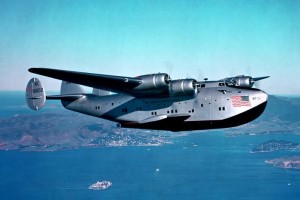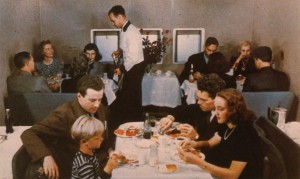The California Clipper
Most aviation records set in the pioneering first half-century of manned flight were accomplished after months or even years of careful planning, funding, determination and daring. Often the aviators and their backers were in pursuit of prize incentives offered by newspapers, aviation societies or wealthy enthusiasts. Sometimes, the aircraft was specially designed and built for a single attempt at a record. A great example is the Ryan NYP (New York to Paris), dubbed the Spirit of St. Louis to recognize the financial backers. Charles Lindbergh piloted the Spirit of St. Louis in 1927 in the first successful attempt at a solo non-stop crossing of the Atlantic and claimed the Orteig Prize.
Such was not the case with the first round-the-world trip by a commercial airliner. In fact, when the crew of Pan Am’s California Clipper left Los Angeles on December 2, 1941 for a regularly scheduled round-trip flight to Auckland, New Zealand, they had no idea they were going to set an aviation record, that they were going to go around the world, and that they would be gone from home five weeks.
So how did the California Clipper come to set a record for traveling around the world? What happened was the Japanese attack on Pearl Harbor, which occurred on December 7th, when the clipper was en route to New Zealand. When they landed at Auckland, the captain and crew discovered they were in the middle of a war zone, in possession of a large and valuable aircraft, and easy prey to Japanese fighters. Ruling out a return trip by the way they had come, Pan Am instructed Captain Robert Ford to continue flying westward. There had been no plan for this of course, so there were no navigation maps, no carefully scouted re-feuling stops, no waiting maintenance hangars. Leaving Auckland and headed west, the clipper began a month-long odyssey characterized by hazards, improper fuel, overloaded take-offs and close calls with the enemy (at one harbor they were confronted by a Japanese submarine, and had to beat it to get out of the range of its’ guns).
With grit and determination, Captain Ford and the crew were able to finally bring the clipper home to the Marine Terminal at La Guardia Field, New York on January 6, 1942. “The flight was a thirty-four day ordeal. It took over 31,000 miles, 3 oceans, 5 continents, 12 nations, 22 landings, and crossed the equator 4 times.” [7] After the California Clipper was safely brought home, Pan Am renamed it the Pacific Clipper, partly due to the media attention it was receiving. Soon after, the Pacific Clipper, along with all of Pan Am’s flying boats, was requisitioned by the Army Air Force for military duty, although it continued to be flown by the experienced Pan Am crews. After the war, the concept of the commercial flying boat gave way to land-based airplanes, and the now-obsolete Pacific Clipper was sold to Universal Airlines. It never flew commercially again, however: it was heavily damaged in a storm and consequently sold for scrap.
Vox’s Take: Sadly, none of the Boeing B-314s survive today. There is, however, a full-scale mock-up at the Foynes Flying Boat Museum in Limerick, Ireland [4] – one of the terminals for the Pan Am clippers flying Atlantic routes.
Sources:
[1] Boeing B-314, Virtual Aviation Museum
[2] Pacific Clipper, Wikipedia
[3] Boeing 314, Wikipedia
[4] Boeing B314, Foynes Flying Boat Museum
[5] The Long Way Home – Revised Edition, by Ed Dover
[6] 75th Anniversary Celebration of the China Clipper, Pan American Airways
[7] Pacific Clipper: The Untold Story, Albert S. J. Tucker and Matthew W. Paxton with Eugene Dunning

